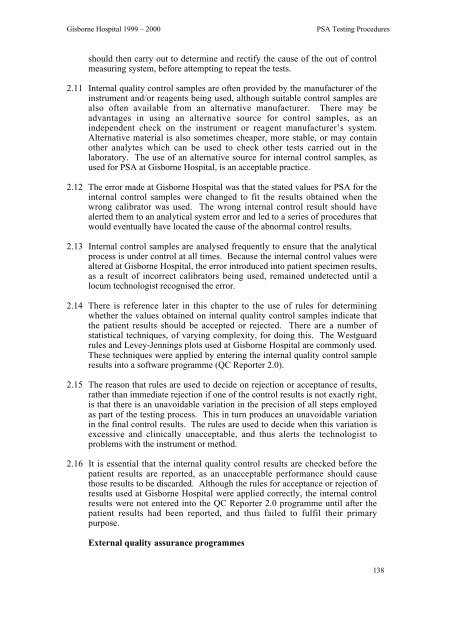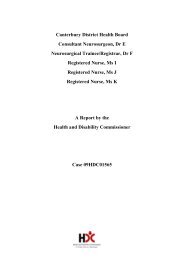Gisborne Hospital Report - Health and Disability Commissioner
Gisborne Hospital Report - Health and Disability Commissioner
Gisborne Hospital Report - Health and Disability Commissioner
Create successful ePaper yourself
Turn your PDF publications into a flip-book with our unique Google optimized e-Paper software.
<strong>Gisborne</strong> <strong>Hospital</strong> 1999 – 2000<br />
PSA Testing Procedures<br />
should then carry out to determine <strong>and</strong> rectify the cause of the out of control<br />
measuring system, before attempting to repeat the tests.<br />
2.11 Internal quality control samples are often provided by the manufacturer of the<br />
instrument <strong>and</strong>/or reagents being used, although suitable control samples are<br />
also often available from an alternative manufacturer. There may be<br />
advantages in using an alternative source for control samples, as an<br />
independent check on the instrument or reagent manufacturer’s system.<br />
Alternative material is also sometimes cheaper, more stable, or may contain<br />
other analytes which can be used to check other tests carried out in the<br />
laboratory. The use of an alternative source for internal control samples, as<br />
used for PSA at <strong>Gisborne</strong> <strong>Hospital</strong>, is an acceptable practice.<br />
2.12 The error made at <strong>Gisborne</strong> <strong>Hospital</strong> was that the stated values for PSA for the<br />
internal control samples were changed to fit the results obtained when the<br />
wrong calibrator was used. The wrong internal control result should have<br />
alerted them to an analytical system error <strong>and</strong> led to a series of procedures that<br />
would eventually have located the cause of the abnormal control results.<br />
2.13 Internal control samples are analysed frequently to ensure that the analytical<br />
process is under control at all times. Because the internal control values were<br />
altered at <strong>Gisborne</strong> <strong>Hospital</strong>, the error introduced into patient specimen results,<br />
as a result of incorrect calibrators being used, remained undetected until a<br />
locum technologist recognised the error.<br />
2.14 There is reference later in this chapter to the use of rules for determining<br />
whether the values obtained on internal quality control samples indicate that<br />
the patient results should be accepted or rejected. There are a number of<br />
statistical techniques, of varying complexity, for doing this. The Westguard<br />
rules <strong>and</strong> Levey-Jennings plots used at <strong>Gisborne</strong> <strong>Hospital</strong> are commonly used.<br />
These techniques were applied by entering the internal quality control sample<br />
results into a software programme (QC <strong>Report</strong>er 2.0).<br />
2.15 The reason that rules are used to decide on rejection or acceptance of results,<br />
rather than immediate rejection if one of the control results is not exactly right,<br />
is that there is an unavoidable variation in the precision of all steps employed<br />
as part of the testing process. This in turn produces an unavoidable variation<br />
in the final control results. The rules are used to decide when this variation is<br />
excessive <strong>and</strong> clinically unacceptable, <strong>and</strong> thus alerts the technologist to<br />
problems with the instrument or method.<br />
2.16 It is essential that the internal quality control results are checked before the<br />
patient results are reported, as an unacceptable performance should cause<br />
those results to be discarded. Although the rules for acceptance or rejection of<br />
results used at <strong>Gisborne</strong> <strong>Hospital</strong> were applied correctly, the internal control<br />
results were not entered into the QC <strong>Report</strong>er 2.0 programme until after the<br />
patient results had been reported, <strong>and</strong> thus failed to fulfil their primary<br />
purpose.<br />
External quality assurance programmes<br />
138
















